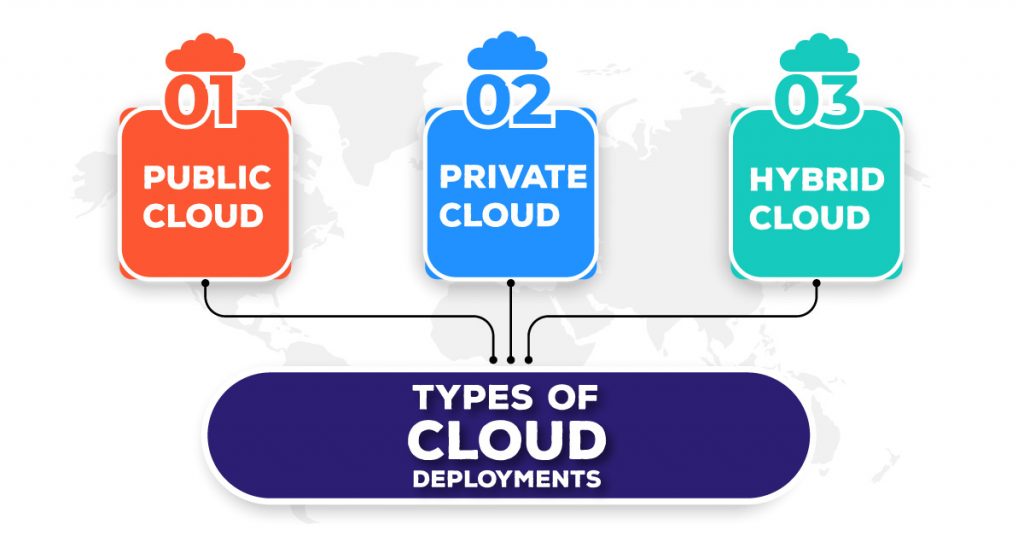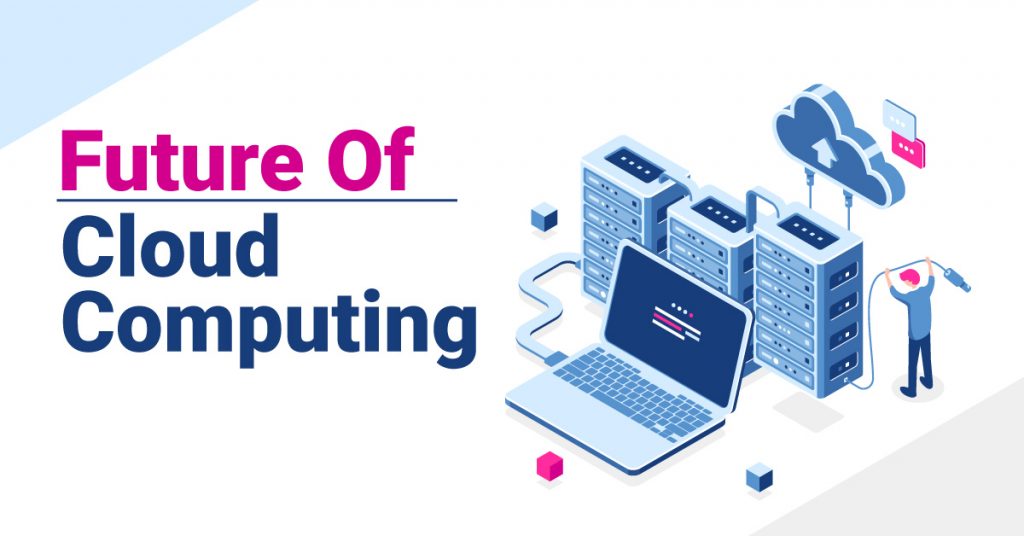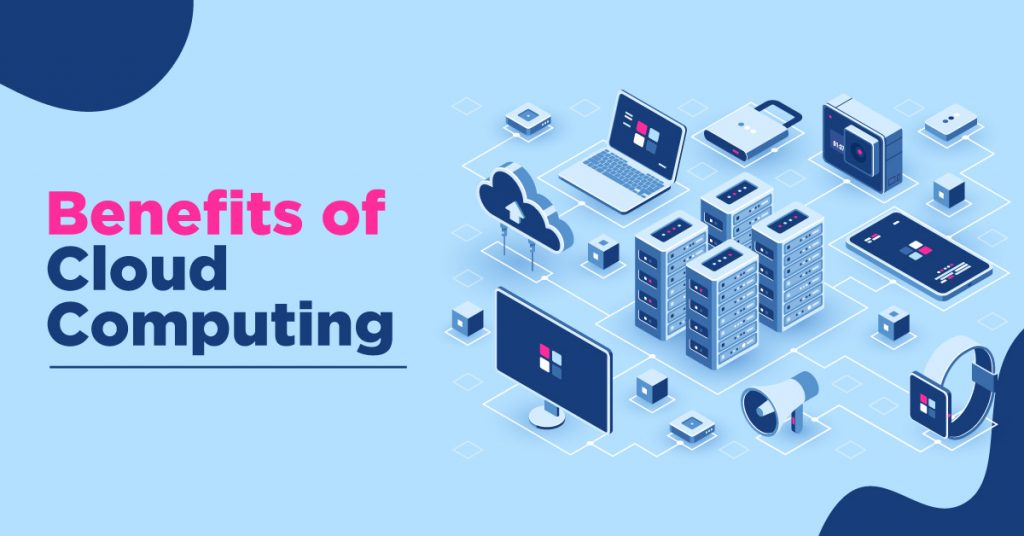The concept of cloud computing is now not a mystery. It’s a term that is used multiple times in every aspect of modern technology and digital transformation. It is globally accepted that the cloud is going to be a part of everyone’s and everyday life – still, the implications of the cloud shift are not yet completely known. But being unaware of cloud architecture and what it can give us means that we are taking this technology for granted.
In simple words, cloud computing is the sharing of computing services over the Internet (that involves storage, analytics, servers, networks, software, and databases) to facilitate speedier innovation, more flexible resources, and provide cost cuts by providing high scalability. Cloud computing technology helps you save money and improve the efficiency of infrastructure as your business grows and you only pay for the used cloud services. Also, you can transform the services to your needs.
Cloud computing technology is getting popular among the technical and business sectors these days, but it can also be useful in addressing social issues. E-Government has recently been applied in undeveloped countries to increase government efficiency and effectiveness. The Indian economy is based on agriculture, and the majority of the population lives in rural areas. The standard of living, agricultural production, and other factors can all be improved by properly using cloud computing. Thus cloud computing applications can face technological and social challenges both.
In 2020, End-user spending on cloud services is totaled $270 billion. This figure is predicted to rise by 23.1% to $332.3 billion in 2021. According to experts, this figure is expected to surge to $397.5 billion by 2022.
What is Cloud Computing?
Cloud computing has become the buzzword today because major companies such as Google, IBM, and Amazon are giving marketing and services. Cloud computing is the next step in the Internet’s development. Though “Cloud Computing” seems important but not, in reality, cloud computing technology is something we’ve been using for a very long time; it’s the internet facility, and the associated standards, that give users a set of web services. The main qualities of cloud computing are shown when users draw the term “Internet” as a “cloud.”
We can also understand the cloud as a network or internet. A cloud is anything that occurs at a remote location. Cloud services can be delivered in WANs, LANs, and VPNs across public and private networks.
E-mail, online conferencing, and customer relationship management (CRM) are all examples of Cloud-based applications.
Cloud Computing is mostly used in the corporate world nowadays for the following reasons:
Security issues associated with data.
- Concern related to dependency on services that are controlled by third parties companies.
- Some companies will become leaders in charge while others will lag from the others.
- According to the definition of The National Institute of Standards and Technology (NIST) cloud computing.
A model for enabling convenient, on-demand network access to a shared pool of configurable computing resources that can be fastly provisioned and released with minimum management effort or service provider interaction.
There are multiple different ways to define cloud computing, it all comes down to these 5 key points:
- Networking
- Data management
- Storage
- Services
- Devices
Types of Cloud Services

The cloud computing service field has become a quickly growing multi-billion-dollar sector. Gartner estimates cloud spending will become a $332 billion industry by the end of 2021. And Gartner is not the only one in highlighting cloud computing’s growing prevalence in the industry.
In the Project of Cloud Vendor Revenue Projection, 2017, Wikibon estimates that all types of categories comprising the enterprise cloud will expand at a CAG(compound annual growth) rate of 19% from 2016 – 2026. Whereas, on-premise software, traditional infrastructure, and legacy methods of process in business outsourcing will experience a negative 3% CAGR.
The dynamic effects of cloud adoption are already playing out and are most evident in the 3 wide-ranging models of cloud computing services: infrastructure-as-a-service (IaaS), software-as-a-service (SaaS), and platform-as-a-service (PaaS).
Another characteristic that defines the cloud is that the storage, networking, computing, and integration abilities of each SaaS, PaaS, and IaaS offer are effectively owned by the vendor and delivered as an on-demand service, subscription basis to the customer.
These 3 types are designed to be stacked one on top of another, which means they can work by themselves without any support of each other or in a combination also. Think about a 3-tiered pyramid with SaaS sitting on top giving benefits to the end-users, PaaS in the middle helping developers and serving integration needs, and IaaS at the base helping administrators of the system.
1: Software-as-a-Service (SaaS)
Generally known as the “on-demand software,” SaaS is the most commonly used service of cloud computing for customers. With a wide variety of service types and applications, SaaS is replacing traditional enterprise systems including ERP, accounting, customer relationship management (CRM), inventory management and supply chain, and human resources management programs, among many others. Since SaaS doesn’t need to purchase an expensive licensed program, users can use multiple cloud applications on an as-needed basis and all for free. From the Report of State of the SaaS-Powered Workplace, the average business has 16 SaaS applications deployed, a 33% jump over the last year.
2: Platform-as-a-Service (PaaS)
Imagine PaaS being the middleman of cloud services as it sits at the center, linking SaaS & IaaS. This service of the cloud gives users all the tools required to make a digital platform. It features the platform for networking, storage, and virtual servers with hardware and software necessary to design, develop, test, implement, manage, and operate applications while integrating, analyzing, and sharing data.
3: Infrastructure-as-a-service (IaaS)
The IaaS layer provides important or necessary database storage, building blocks, and a virtual platform. By developing cost-saving and scalable IT solutions, the complex and costly hardware is outsourced to a third-party vendor of the cloud. All of these IT services are automated for customers who can self-provision the storage or processing power of the IaaS platforms. Vendors are also responsible for current maintenance, involving system upkeep, business steadiness, and backing up data.
Types of Cloud Deployments

How a company manages and saves business assets and requirements can be reflected in how it deploys its cloud service. But cloud deployment is more than just a debate of “private cloud vs. public cloud”. The generation of hybrid cloud deployment has added a whole different flavor to the scenario.
1. Public Cloud
A public cloud is maintained by using a third-party provider of the IaaS cloud. Servers, storage, and some other digital resources are provided over the internet. As the provider covers all bandwidth and maintenance costs, a customer only uses a web browser to access services and to manage his accounts.
Pros: Reliable service, cost-effective through economies of scale, elastic scalability, no maintenance.
Cons: Often deemed unsafe for managing highly private and sensitive data; must comply with strict security regulations.
2. Private Cloud
In private cloud computing services, infrastructure, and networking are managed solely by a company independent of other organizations or public platforms. A private cloud can be maintained in any of these two ways: A company’s data center is physically located in-house, or a third-party vendor is paid to host everything privately.
Pros: More control, scalable, secure, flexible.
Cons: Expensive maintenance (if kept on-site).
3. Hybrid Cloud
As assumed, a hybrid cloud deployment is a combination of public and private clouds. This infrastructure permits data, information, and apps to be shared and transmitted interchangeably. The private side can be used for private processes like finance service and data recovery, whereas the public side can run high-volume applications
Pros: Enhanced agility, security, accessibility.
Cons: More maintenance, complex compatibility.
Salary of Cloud Engineer
Look at the cloud engineer income based on their experience.
It’s clearly visible that in only 4 years, you can expect to make 3 times as much as you would as a fresher. There are multiple popular job profiles in the cloud-related field, including SysOps Engineer, Solutions Architect, and DevOps Engineer. Cloud engineers with recognized certifications from cloud providers such as AWS, Azure, and GCP are granted these profile jobs.
All of the certifications focus on a certain point of cloud computing. After becoming a cloud engineer, it’s generally a specialty.
Let’s know how much each of these cloud engineers earns on average.
Future of Cloud Computing

No one knows the future, but one can only predict it, by analyzing the current usage and trends. Below, are some of the predictions about Cloud computing:
1. Increase Storage Capacity
Nowadays, data is created in a high volume and it’s complex to store it securely. Most organizations need a place where they can securely store their sensitive data.
So many organizations are introducing cloud computing to their systems and it has been predicted that the Cloud providers will provide many data centers at a cheap cost as there is a huge competition between them. With the help of the more in your company will be able to store the data securely and also at low cost.
2. Enhanced Performance of Internet
With the assistance of the Internet of Things(IoT), the quality of the internet can be accelerated. We can save data in the cloud using the Internet of Things and Cloud Computing, then analyze it and deliver better performance.
The users expect high-quality fast-loading applications and services. The network given will be faster and the capability to download and send that data will be faster.
3. Modular Software Will Be Priority
The size of a single program along with the complexity is increasing on a daily basis. This can take us to the fact that Cloud technology will soon require an advanced thinking system.
We can see software development from multiple angles as the future applications will store in places other than the cloud. This application will store on multiple modules, on servers of multiple Cloud services.
This can also lower the cost of software as placing components of the program on multiple different storages is much more economical.
4. Internet of Things(IoT) Along With Cloud Computing
The Internet of Things(IoT) is also one of the leading technologies with continuous innovation in real-time Analytics of Data and cloud computing. There are multiple machine-to-machine(m-to-m) communication channels, data, and processes occurring. We can do it without any complexity only with the help of cloud computing.
5. Improvement in Cloud Services
Cloud Computing involves:
- Infrastructure as a service
- Platform as a service
- Software as a service
With these services, organizations can achieve their desired goals. There are many researchers who have researched that Cloud Computing is going to be one of the leading technologies in the future as software as this service solution will remove more than 60% of the workload.
It is also predicted that the platform as a service and infrastructure as a service will accelerate slowly as it has been used in most companies. Cloud Computing is user-friendly and is compatible with both new and organizations with traditional processes.
6. Security
The data which are stored in the cloud is secure but not completely secured. Small companies which are providing cloud services can or can not provide complete security of your data.
So in the future, we can prevent cyber-attacks by providing complete security and not hiding anything from the customers. The cloud vendors provide better security measures opening balanced ways to prevent cyber attacks from attackers.
7. Modular Software
Organizations are using such software, which is yet to be modified. This leads to the fact that cloud computing needs modified software, which will provide better facilities and security. This software will be more user-friendly and flexible to use when it is completely modified.
One of the major pros of this software is that it saves money and time.
8. Economic
If cloud computing will continue to evolve at this speed the use of hardware like hard disks and pen drives will be less as most of the work will be done with the assistance of cloud computing. We can remove the setup cost of software by dividing it and this will decrease the use of hardware.
If the rate of evolution continues at this rate, the data saved and stored in the cloud will be processed by a program without the need for human intervention.
Benefits of Cloud Computing

Nowadays the business environment depends more and more on devices with Internet of Things abilities (especially smartphones). As a result, many offices are converting into virtual workspaces. Therefore, easier and more efficient access to data can be done through cloud computing.According to a recent study by a market research company, Vanson Bourne declared that cloud computing is having a measurable business impact. Organizations that have adopted cloud services have seen a nearly 21% accelerated market speed, a 19% jump in process efficiency, and a 20% uplift in organizations’ growth. Here is a list of benefits cloud computing can provide to an organization.
- Flexible costs: Cloud computing spins the whole traditional capital expenditure (CAPEX) spending, instead, the majority of cloud spend is OPEX(operational expenditure). As a third-party provider will be responsible for the maintenance, An organization doesn’t have to provide money to a support team to solve the problem of servers.
- Improved mobility: Using the cloud, apps and data can be accessed anywhere and anytime. And that’s all because of the ever-increasing number of mobile devices like tablets and smartphones. The “anywhere, anytime” advantage also particularly applies to business. Employees gain flexibility, becoming more efficient with workflows and service for the customer also increases.
- Increased collaboration: Cloud computing is basically developed for the betterment of work processes, and that involves data flow between coworkers and business partners. Organizations demand more apps for streamlined workflows and file sharing. Remote workers can quickly connect and communicate with fellow employees and important clients and even can transfer data over the cloud networks.
- Economies of Scale: Cloud computing compresses the cost by holding economies of scale. According to a study by Booz Allen Hamilton, the cloud strategy could reduce the cost of deploying 1000 servers by 50 to 67 %. Cloud customers can take benefits of lower costs from providers’ economies of scale, reducing their investments in on-premises infrastructure.
- Operational: Technology is not perfect and even in the future also it will not, but some of them are just less complex than others. That includes the infrastructure of cloud computing, which usually runs on different servers using a third-party vendor. So, when problems do arise, it’s the vendor’s job to fix the problem instead of having an on-site IT staff who will spend time and resources on fixing the issues.
Effect of Cloud Computing on Human Lives

Business owners who are unfamiliar with how common and beneficial cloud services are in their daily lives are less likely to see the advantages of using them everywhere. With all that in mind, consider the various cloud computing advantages and numerous ways in which the cloud affects our daily lives.
- Social Media
All social networking applications are based on cloud computing basics. A photo that you post to Facebook or Instagram is stored in the cloud. And no one can disagree that social media has an impact on how people live their lives these days.
- Entertainment
Before cloud computing technology, we could only watch and listen to what was broadcast on television or on the radio. The fact is that the cloud has changed how we consume content. Netflix and other platforms allow us to watch any show we want on-demand, while music streaming services allow us to listen to our favorite songs anytime. All of these services have one thing in common: they use the cloud to deliver content to us.
- Healthcare
One of the most important cloud computing advantages in everyday life is in healthcare. Smartwatch users, for example, can enable their device to track specific data such as their heart rate or the number of calories they burn each day. This information is saved in the cloud, where it may be retrieved by a physician who can keep track of the patient’s health. In addition, some doctors’ offices have set up cloud-based patient portals where patients can access essential health data and a variety of other information.
- Shopping
Have you ever thought about how Amazon knows what to recommend to you or how it provides a one-click purchase? The answer is they save all of this data in the cloud so that it can be accessed at any time. Most online retailers use the cloud in some fashion to store information that makes future purchases easier to complete.
- Education
These days students have access to education that most of us could only dream of. Universities around the country are now offering online courses, with certain degrees available fully online. Information, classes, and other resources are saved on the cloud, allowing students to access requested data at any time and from any location.
- Personal Storage
If you have an iPhone, your images are most likely stored on iCloud. If you’ve ever wanted to send a large file to a friend, you’ve most likely used Dropbox or Sendspace to do so. If you use Google’s or Microsoft’s personal Gmail or Hotmail email services, your data is stored on Google’s or Microsoft’s cloud servers. Cloud storage has become so common that most individuals are unaware that they use it. It’s funny, though, to hear someone say they’ve never used the cloud. The truth is that if you’ve ever used free email, you’ve already used the cloud.
CONCLUSION
One of the interesting aspects of cloud computing technology is how quietly it has entered most people’s lives. It’s almost impossible to stay out of the cloud. It has become so integrated with daily lives that we are unaware that it exists and is being used. Many of life’s comforts are linked to cloud technology in one way or another. Many small enterprises, however, do not automatically associate this frequency in everyday life with its commercial potential. However, once you grasp how the cloud has benefited everyday life, it’s easy to see how this technology can boost a small business.
On the whole, cloud computing is here to stay for a long time. Businesses require to leverage this technology and grow parallelly with it. The technology is both inspiring and powerful and the latest. In the long run, it proves to be a cost-effective way of executing services for multiple businesses, both small and big. As cloud computing has a bigger scope, especially in terms of reachability, it is bound to have a great future. Both customers and the host service providers will use the benefits of this technology.














One response to “Cloud Computing | A Complete Journal”
[…] Cloud engineers must have technical capabilities as well as the ability to negotiate terms with vendors, manage data security, and follow best practices throughout the process in order to complete the migration. These experts also collaborate with IT teams to integrate existing structures into cloud-based systems and report progress to senior management. Here you can refer the complete guide of cloud computing. […]